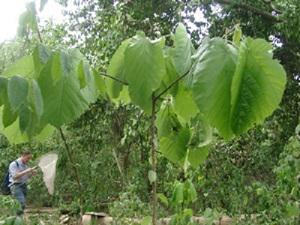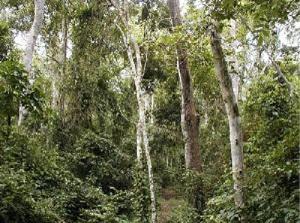Cossi Aristide Adomou
The project aims to assess the conservation value of rain forest relics in terms of overall and threatened species richness, tree population structure, forest type uniqueness, use patterns.

Sapling of Mansonia altissima (Malvaceae), an Endangered plant. © Neuenschwander P., 2007.
Southern Benin belongs to the Dahomey Gap, which can be defined as the climatically dry corridor separating the West African rain forest into the Upper and Lower Guinean forest Blocks. The current vegetation is a forest-savannah mosaic of fallows, fields, oil palm plantations, and rain forest patches. The rain forest remnants provide habitats for c. 30% of the total flora that is estimated to count 3000 plant species. A great deal of the forest species displays a range-restricted distribution so that they can be regarded as rare. Furthermore, these forest patches provide habitats for about 20 globally threatened plant species. However, these areas of high conservation priority have not yet gained any attention from local conservationists including the Forest department and NGOs. Most of them are communal forests and human pressure on them keeps increasing. For these species to be preserved along with their habitat sites in which they occur have to be protected. Information on habitat characteristics, distribution patterns, and population demography of threatened species, is required before conservation measures be taken and applied. For species with poor demographic prospects, active intervention is required to improve seedling and tree growth, enrich populations with seedlings from controlled germination, and restore habitat.

Protected forest of Lama, a semi-deciduous forest type. © Adomou A.C., November 2004
The conservation of habitats constitutes one of the major targets of the Convention on Biological Diversity through its global strategy for plant conservation. Meeting this biodiversity conservation target requires every country to be engaged in systematic conservation planning, which is not so effective in Benin. The rain forest remnants in southern Benin only cover c. 20000 ha, and have not so far gained any attention from conservationists. Setting conservation priorities for these forests and globally plant species is vital, since they constitute the only source of non-timber forest products for the local population. Information on many rare species is extremely scarce or lacking. The survival and persistence of many threatened and endangered tree species is in doubt considering the rate of deforestation of 1.25 % per year. Information is lacking on their identity, natural stands, population demography, natural regeneration, establishment and management and utilization of these species. Thus, the current project will contribute to filling this gap in a way to develop proper conservation strategies for the c. 20 globally threatened species and their habitats. Sessions of communication, education and public awareness will be organised to underpin habitat and species conservation in Benin.